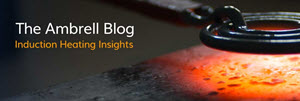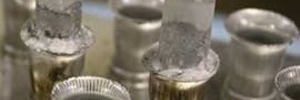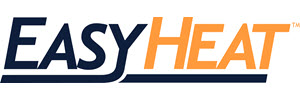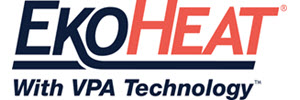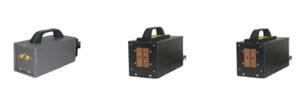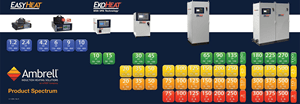Induction Brazing Aluminum
Induction Brazing Aluminum
- Home
- Applications
- Aluminum Brazing
What is Induction Brazing Aluminum?
Induction brazing aluminum addresses the issues of torch and furnace brazing by removing the requirement for a skilled operator, by reducing energy costs and by decreasing the equipment footprint while implementing a lean manufacturing process for higher quality parts.
Induction brazing aluminum Benefits
-
Meets tight production tolerances with precise localized heat to small areas creating pinpoint accuracy
-
Increases production rates with faster heating cycles
-
Reduces defect rates with repeatable, reliable heat
-
Eliminates variability from operator-to-operator, shift-to-shift
-
Maintains metallurgical characteristics of the individual metals
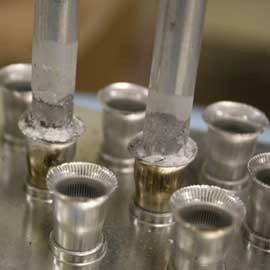
Select from our collection of brazing aluminum notes, taken from years supporting our customers. Read how we helped to solve their process heating challenges.
 Brazing an Aluminum Tube Assembly
Brazing an Aluminum Tube Assembly
A custom-designed single position multiple-turn pancake coil was built to generate the required heating for this brazing application. Initial tests were conducted to optimize power delivery to the assembly
 Heating Wires and Strips for Coating Removal
Heating Wires and Strips for Coating Removal
The polymer coating on the aluminum strip behaved differently when heated. Visually, the coating turned brown and bubbly when the aluminum strip was heated
 Heating an Aluminum Tube for Bending
Heating an Aluminum Tube for Bending
Induction does not present an open flame into the work environment like a torch, resulting in a safer working environment
 Heating aluminum wire to create screens
Heating aluminum wire to create screens
Induction will double production due to more rapid heating than infrared lamps can offer; with induction 100 feet per minute can be run instead of 50 feet per minute with infrared
 Brazing aluminum adaptors to the end of aluminum tubes
Brazing aluminum adaptors to the end of aluminum tubes
To increase production, a multi-position coil was recommended so multiple parts could be heated while maintaining a cycle time of 55 seconds, delivering consistent joint quality, which a torch often doesn't deliver.
 Tempering an audio speaker screen
Tempering an audio speaker screen
The speaker screen was placed over the induction coil and the power was turned on. The screen heated to the desired temperature within just one second
 Heating an aluminum-backed circuit board to reflow solder
Heating an aluminum-backed circuit board to reflow solder
Given the significantly faster heating time, induction improves throughput in this process and is a more efficient heating method than hot plate heating
 Brazing tubes and fittings for an air conditioning unit for the off-road market
Brazing tubes and fittings for an air conditioning unit for the off-road market
Clients were using an oven, and because the whole part was being heated and essentially annealed, it created problems with the part. Induction only heats the braze area, and resolves that issue...
 Brazing an aluminum assembly for a bicycle manufacturing application
Brazing an aluminum assembly for a bicycle manufacturing application
For this aluminum bicycle tube brazing application, induction heating delivers more repeatable and consistent results, while cutting client's heating time in half when compared to using a torch...
![image: Brazing an aluminum manifold [air conditioning]](https://www.ambrell.com/hs-fs/hubfs/ambrell-images/Applications/Thumbs/brazing_74.jpg?width=95&height=95&name=brazing_74.jpg) Brazing an aluminum manifold [air conditioning]
Brazing an aluminum manifold [air conditioning]
Precise, repeatable heating: The client wanted more precise and repeatable heating than a torch could deliver, which induction was able to achieve..
Induction heating delivers higher quality end product vs. using an open flame convection furnace. Ovens are sensitive to ambient temperature and humidity variations and tend to produce uneven results
 Pre-heating aluminum wheels prior to spray painting
Pre-heating aluminum wheels prior to spray painting
This spray painting application requires pre-heating the material. Additionally, there is a requirement that the material must not cool below a certain target temperature prior to the spray.
 Brazing two aluminum pipes to an aluminum evaporator core
Brazing two aluminum pipes to an aluminum evaporator core
The customer is replacing a flame process which can burn away the thin flange at the joint area and create scrap parts. By switching to induction for this application the customer is decreasing their scrap parts and also increasing their quality and production rate...
 Heating top of aluminum oxygen tank for end forming
Heating top of aluminum oxygen tank for end forming
Through heating the top 2 (50.8mm) of aluminum oxygen tank to form a rounded end with a hole for oxygen valve
 Brazing aluminum electrical lug assembly
Brazing aluminum electrical lug assembly
A five turn helical coil is used to braze the assembly. The parts are assembled and placed in the coil. Power is applied and a braze stick is used to braze the two parts in 25-30 seconds...
 Induction Bonding Aluminum & Carbon Fiber Coupons
Induction Bonding Aluminum & Carbon Fiber Coupons
To enable the process of bonding with induction, three custom-designed single position multiple-turn coils were built to generate the required heating for this application (helical, pancake and u-shaped coils).
 Shrink Fitting an Aluminum Tube (optical system)
Shrink Fitting an Aluminum Tube (optical system)
With an EASYHEAT 2 kW induction shrink-fitting system, the aluminum tube heated to the required temperature within 30 seconds. Shrink fitting then took place
 Heating aluminium susceptor for powder expansion
Heating aluminium susceptor for powder expansion
Expand powder into solid form for use in crash helmets
 Shrink fitting an automotive aluminum motor housing
Shrink fitting an automotive aluminum motor housing
Induction shrink-fitting is fast, presents significant energy savings over an electric oven, requires a more modest footprint than an oven and can be easily integrated into an automated process
 Soldering an LED assembly to an aluminum spotlight housing
Soldering an LED assembly to an aluminum spotlight housing
A multi turn pancake coil is used to heat the bottom of the aluminum spotlight housing. The LED housing was not available so this application is done with temperature sensing paint to determine the feasibility
 Inserting a Steel Bushing to an Aluminum Hub
Inserting a Steel Bushing to an Aluminum Hub
The client currently uses an electric oven and the heating time is two hours, so at 60 seconds, the time savings with induction shrink-fitting is very significant
 Annealing aluminum fuel tank fill neck for bending
Annealing aluminum fuel tank fill neck for bending
An eight-turn helical is used to heat the aluminum tube for annealing. To anneal the full length of the tube, the tube is placed in the coil and heated, and then the tube is bent while hot to prevent cracking.
 Curing a coating; both sides aluminum piston
Curing a coating; both sides aluminum piston
A three turn channel coil 19 (48.26cm) long is used to anneal 4 pistons running though the coil with a distance of 6 (15.24cm) between centers.
 Reflowing the solder of an area on a circuit board
Reflowing the solder of an area on a circuit board
An aluminum fixture is a large heat sink to the induction field. In order for solder alloy to wick and run the length of the overlap area, flux is applied to the solder location...
 Curing epoxy on aluminum copier roller assembly
Curing epoxy on aluminum copier roller assembly
A four turn helical pancake coil is used to heat the end of the copier roller assembly. The assembly is heated 90 seconds to cure the adhesive.
 Sealing an Aluminum Cap Seal on a Plastic Jug
Sealing an Aluminum Cap Seal on a Plastic Jug
To heat one aluminum cap seal on a plastic jug for a cap sealing application. The client is replacing past systems that no longer work for their process.
 Curing plastisol adhesive on an aluminum filter assembly
Curing plastisol adhesive on an aluminum filter assembly
A four turn helical coil is used to cure the plastisol adhesive. One filter end cap is filled with adhesive, attached to the filter and heated 90 seconds to cure the adhesive.
 Shrink-fitting auto turbo charger impeller blades onto an aluminum shaft
Shrink-fitting auto turbo charger impeller blades onto an aluminum shaft
Induction heating provides repeatable results, reduced cycle time, lower consumables cost and even distribution of heating
 Bonding Foil to a Plastic Bottle
Bonding Foil to a Plastic Bottle
It was confirmed that the aluminum heated sufficiently to create a bond between the foil and the bottle, meeting the client’s objective.
 Curing ink on aluminum bottle caps
Curing ink on aluminum bottle caps
A double channel coil is used for the ink drying application. Fifteen bottle caps are placed inside the coil and power is applied for 3 seconds to dry the ink.
 shrink-fitting aluminum pulley to insert inner bearing
shrink-fitting aluminum pulley to insert inner bearing
A three turn helical coil is used to heat the aluminum pulley. The pulley is heated to 464 °F (240 °C) in 20 seconds to expand the inner diameter and then the inner bearing is inserted to form the completed part.
Automotive manufacturers are constantly searching for cost-effective production technologies.
 Sealing an aluminum disk onto a plastic cap
Sealing an aluminum disk onto a plastic cap
Induction heating enabled the aluminum to seal to the plastic cap quickly without the cap being damaged. The customer desired a quick rate which would make in-sourcing the process worthwhile, and induction heating exceeded the targeted production rate thanks to its fast heating.
 Induction Melting aluminum in a graphite crucible for casting
Induction Melting aluminum in a graphite crucible for casting
Induction melting provides hands-free heating that involves no operator skill for manufacturing, repeatable, dependable results, more efficient and cost effective then gas furnace, does not heat up the manufacturing area and increases production.
 Cap Sealing; Shampoo Container
Cap Sealing; Shampoo Container
A three-turn two-position helical coil is used to heat the aluminum foil in a tunnel style assembly. Product (containers) passes easily under the induction coil.
 Heating Aluminum Auto Trim for Adhesive Curing
Heating Aluminum Auto Trim for Adhesive Curing
To heat various sizes of aluminum auto trim to 500°F (260°C) at a rate of 30 ft. (9.1m) per minute for curing an adhesive.
To heat an aluminum catheter tipping die to above 2850F within 2 to 5 seconds for the forming of catheter material.
Our Induction brazing aluminum Systems and Equipment
Four Ways To Contact Ambrell for Support
AMBRELL CORPORATION
1655 Lyell Avenue
Rochester, NY 14606
United States
F: +1 585 889 4030
AMBRELL B.V.
Holtersweg 1
7556 BS Hengelo
The Netherlands
AMBRELL Ltd.
Unit 6, Space Business Centre
Tewkesbury Road
Cheltenham, GLOS, GL51 9FL
United Kingdom
F: +31 546 788 154
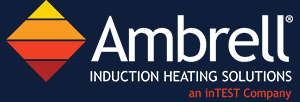

 Preheating aluminum flanges
Preheating aluminum flanges Curing Alumium Car Molding
Curing Alumium Car Molding Heating Catheter Tipping Die
Heating Catheter Tipping Die